Once upon a time, buyers of coloured stones were solely focused on colour and size, but in the 21st Century, gemstone and jewellery customers are becoming more aware of the effect of the cut on coloured gemstones.
Gemstone grading laboratories started issuing cut grades on diamonds in 2006 – which caused the entire diamond industry to become more conscious of the cutting quality – but in coloured gemstones, this revolution has yet to arrive.
Some laboratories are starting to issue cut grades on reports and a few have even offered the option of including the cutter’s name as an attempt to add value and provenance to a gemstone.
Each type of cutting style offers unique benefits to the gemstones, whether that means enhanced colour, weight retention, or more sparkle.
When the cutter picks up a piece of rough in order to plan the cut, they must make many complex decisions around how the stone will be cut, with respect to the rough stone’s original shape, colour, and weight.
In an attempt to make gemstone and jewellery buyers more aware of the benefits of different types of cutting, this guide outlines the benefits and differences between some of the most popular cuts.
Cutting quality
A disclaimer must be made in a guide such as this – not all cutting is equal.
The stones that are about to be presented here are perfectly cut to represent the best qualities of each cut. When you enter a gem market, this is not always – and not usually – the case.
Often, we find stones in the market whose cut has been compromised in order to make the best use of the original rough.
For buyers, this means that we might see a cut that fails to present beauty in some way because it has a window that is leaking light, a poorly shaped outline, is unintentionally asymmetrical, or a myriad of other problems which are outside the scope of this article.

Above: The gemstone cut-and-polish process |
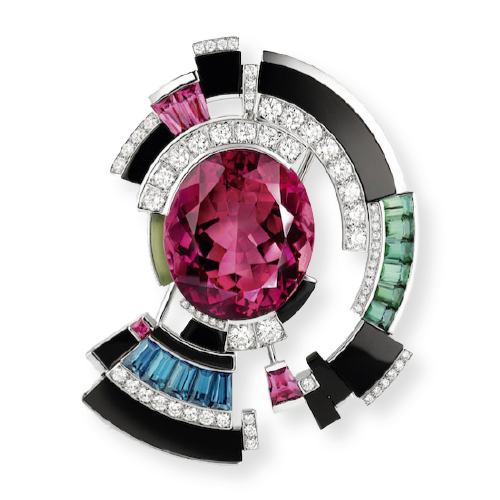 | 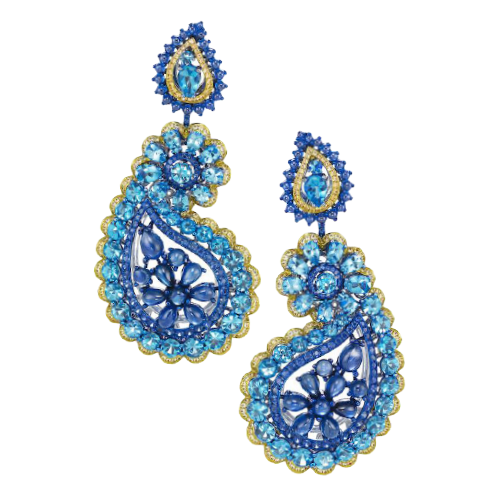 | 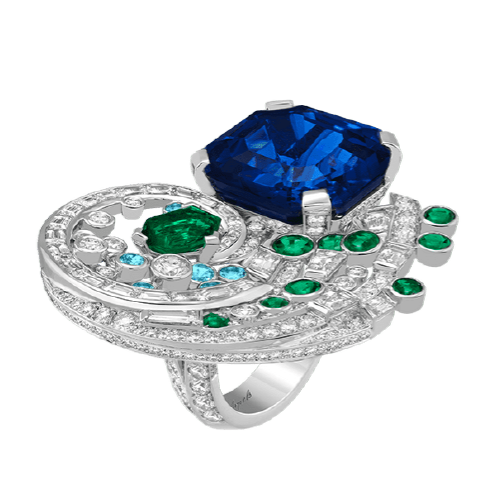 |
| Above: Chaumet 'Labyrinthe' brooch from the Perspectives Collection, featuring oval rubellite, baguette tourmaline, jade and brilliant-cut diamond | Above: Chopard Red Carpet Collection Earrings, featuring brilliant- cut topaz, cabochon sapphire, and brilliant-cut orange and blue sapphire | Above: Van Cleef & Arpels 'Iwamoto' ring from the Sous Les E´toiles Collection, featuring octagonal sapphire, hexagonal emerald, green tourmaline, baguette diamond |
A note on shape
Before we get into cutting styles, a word must be said about the shape of the stone. In almost every example in this article, the outline shape of the stone and the cutting style are independent features of the cut.
For example, a round stone is often cut in the Brilliant style but it’s also possible for it to be cut as a Step cut, a Portuguese cut, a Mixed cut, and many more.
Almost any cutting pattern can be applied to any shape, so there is a creative choice to be made by the cutter when designing the stone.
The outline shape will usually follow the shape of the rough material but the cutting pattern will be chosen based on the colour and tone of the stone as well as the optical effect and visual feeling that the cutter wants to create.
Major cutting styles
Let us begin our journey through the world of gem cuts with the three major styles. There are some cutting styles that we see being used over and over in every type of gemstone.
These three styles represent the most popular cutting styles used throughout the world of coloured gemstones.
» Brilliant – The Brilliant cut is the best cut for creating sparkle and flash in a stone. It reflects more white light and gives the stone a feeling of scintillating light. It’s a great cut for adding life to a stone, especially if it’s light or white coloured.
The downside to this cut is that it loses much more of the stone’s original rough weight and also, since it adds white light into the stone, the colour saturation decreases.
If you have a stone with a moderately deep colour saturation and you give it a Brilliant cut, you tend to lose some of that colour; whereas if you have a dark stone, the Brilliant cut might be just the thing to lighten it up.
The Brilliant cut was originally made to enhance the brilliance of diamonds in the 1600s but was quickly adapted for use in the coloured gemstone world as well.
Any stone can be cut as a Brilliant, though since this is the cut that loses the most weight, we see it used more often in stones of lower value as well as melee.
It’s a cut that is regularly used in garnet and topaz, and rarely seen in emerald and tourmaline; it would be rare to find a Brilliant cut ruby and slightly challenging to find a Brilliant cut sapphire.
» Step – Step cut means that the cut is composed of long parallel rectangular facets. There are different types of Step cuts – both the Emerald cut and Asscher cut although the traditional one is a square or rectangular baguette shape.
Because the pavilion of the stone is rounder and slightly deeper than a Brilliant cut, this style ends up being the best way to retain the weight of the rough stone as well as intensifying the colour saturation.
The Step cut is the traditional cut for coloured gemstones and we can go all the way back to the 1400s to see where it started being used in sapphires, rubies, and later on in emeralds.
The rectangular Step and the Emerald cut are very popular for gemstones that grow in long shapes such as emerald, tourmaline, and aquamarine.
These stones have a crystal habit which is long and pencil-like, and it makes sense to give them long designs with long facets that follow the shape of the crystal.
» Mixed cut – The Mixed cut combines the best of both the Brilliant and Step cut designs.
The crown of the stone is faceted as a Brilliant cut to give the stone sparkle and flash, and the pavilion of the stone is faceted as a Step cut to retain weight and optimise colour.
This is the most popular type of cutting in the world today and many popular cutting houses have put this style in the spotlight.
It originated at the end of the 1800s, coming from the Old Mine-style diamond cut, but has now been adapted with different angles that are more appropriate for coloured gemstones.
We often see this cut used on ruby and sapphire, though any gemstone can be found with this style, from spinel to garnet to tourmaline.
It’s a popular style that makes almost any gemstone look good, though it would probably be hard to find an emerald with this cut.
Popular cutting styles
The next set of cuts are ones that we see frequently in the coloured gemstone market but are not as readily available, as the major three described above.
All of these popular styles are cut in the various cutting centres around the world, and all have unique benefits.
» Portuguese – The Portuguese cut can be very hit-or-miss. The famous cutting houses in Germany’s Idar-Oberstein have been popularising this cut for more than 100 years and, in their careful hands, the cut can make a subtle-coloured stone like a peachy morganite or a seafoam tourmaline look vivid and soft, without becoming too flashy and bright.
Unfortunately, many other cutting centres have adopted this cut as well and typically when you find the cuts coming from India or Thailand, they aren’t well executed.
When done poorly, the cut is used solely to retain weight but at the cost of making the stone look undesirable.
The typical Portuguese cut has a bulky pavilion that makes the stone have a lifeless window when looking into the table, surrounded by a black extinction halo with the true colour of the stone only revealing itself in small areas along the outside edge of the stone.
This cut is a weight-saver so it can be found on all types of stones. Popular stones that are readily found with this cut would be tourmaline, tanzanite, amethyst, kunzite, and aquamarine.
» Cabochon – The Cabochon is the oldest cut for coloured gemstones. It’s the only cut on this list that isn’t a faceted stone.
The top of the stone is a dome that can be shallow or deep. The bottom is flat or slightly rounded to fit into a bezel setting.
A cabochon can also be cut as a Sugarloaf, which means that it has four sides – like a rounded pyramid – which gives an effect like a smooth, colourful piece of candy. The benefit of the Cabochon is that it ‘glows’ colour, whereas a faceted gemstone shines.
The Cabochon is often used for lower-quality transparent material that isn’t as useful for faceting, though for certain materials such as jade and opal, the most premium colours and clarities of the gemstone become the most beautiful in a Cabochon cut.
Cabochons are also the optimum cut for displaying phenomenal effects such as stars, cat’s-eyes and adularescence, which are not visible without a dome shape. The Cabochon was once the only cut and its popularity still continues today.
Every stone can be found as a cabochon but highlights include jade, star ruby and sapphire, opal, emerald (especially as a Sugarloaf), turquoise, cat’s-eye chrysoberyl, moonstone, and labradorite.
» Trillion – The Trillion cut is a three-sided triangular cut and is one of the only styles on this list that is dependent on the shape.
The cutter might choose to use this shape for a piece of rough gem that is naturally three-sided.
The cutting style is usually a Mixed cut with a Brilliant crown and either a Brilliant, Portuguese, or Step cut pavilion.
If the stone is cut on top and bottom in the Brilliant style then sometimes the name can be written as ‘Trilliant’.
The benefit of this cut is that since it has an odd number of sides, each side reflects the light of the two opposite sides making Trillions naturally brighter and more sparkling than other styles.
The Trillion cut is less common than some other styles on this list, so you don’t see as many gemstones readily available in this cut.
The gemstones that you are likely to find are tanzanite, aquamarine, topaz, amethyst, and tourmaline.
» Princess – The Princess cut is essentially a Brilliant cut for square stones. Since the Brilliant cut is composed of triangular shaped facets, it doesn’t fit inside of square shapes.
So, in the early 1900s, gem cutters created this design to be able to give the square shape the same brilliant sparkle that they were able to achieve for round shapes.
The Princess cut started as a popular cut for diamonds but now is used for coloured gemstones and works very well for brightening up dark material – though you don’t often see it used.
It can be used on a square, rectangular or Emerald cut outline, and gives much more flash and light return than a Step cut, but at the cost of losing extra carat weight in the process.
Sapphires are sometimes cut as Princess cut because they are frequently sold on shelves next to diamonds and the cut name often attracts the eyes of diamond buyers.
However, any dark-toned stone would benefit from a Princess cut, such as spinels, tourmalines, and garnets.
» Star – The Star cut is a useful cut that lies somewhere between a Brilliant cut and a Portuguese cut.
Essentially, it’s a Brilliant cut that is given an extra set of facets on the pavilion that can help soften and diffuse lighter colours such as yellow, pink, and peach.
It’s a cut that is often used in India and Sri Lanka but is quite useful on pastel coloured gemstones that might otherwise become too light with a normal Brilliant cut.
The Star cut also has the benefit of giving the typical Brilliant cut a slightly fresher look, so if you want something bright but not so ordinary, this might be a good choice.
Star cuts are commonly seen but aren’t always recognised because of their similarity to Brilliant cuts. You can most often find them enhancing the pastel colours of tourmaline, morganite, aquamarine, topaz, and garnet.
» Asscher – The Asscher cut is another design that was originally created for diamonds but which has recently become popular for coloured stones.
It is a square emerald cut, but when executed correctly can present a very flashy and bright ‘hall of mirrors’ effect.
The stone was named after its creator Joseph Asscher in the early 1900s and went out of fashion until the early 2000s.
Today, we are seeing it presented as a newer cut for coloured gemstones and many people like its shape, which gives a slightly antique feel, harkening back to the Art Deco days from which it originated.
Like the Princess cut, the Asscher cut isn’t a traditional style for coloured gemstones. Usually, the gemstone needs to be custom-cut to find this style; it is most often seen in tourmaline, garnet, spinel, and sometimes sapphire.
Modern cutting styles
There are thousands of modern cuts that could be presented here, but only a few popular favourites have been chosen.
These modern cuts are not usually available in stores or commercially; they are typically designed and cut by boutique cutters in the precision market.
» Opposed Bar – The Opposed Bar cut is an American design from the middle of the 20th Century that gives a unique optical illusion, resembling flashing pixels that light up as the stone is rotated.
The cut needs to be done on a square or rectangular-shaped stone and is comprised of rectangular facets on the crown, running widthwise, and long rectangular facets running perpendicular on the pavilion.
These opposing rectangles give this modern cut style its name and the effect they create is unlike any other design.
The Opposed Bar favours long crystals such as tourmaline, aquamarine, and heliodor. Bi-colour and tri-colour stones work especially well in this cut so watermelon tourmaline and ametrine are particularly stunning in the Opposed Bar style.
» Checkerboard – The Checkerboard cut is a design that has no table; instead, the crown is faceted into tiny squares arranged in a grid that resembles a checkerboard.
Because there is no table, you don’t easily see inside the gemstone, so instead your eye tends to focus on the colour.
This is an excellent cut for material that has inclusions; because your eye becomes distracted by the checkerboard pattern, the inclusions are less obvious, making the gemstone look more presentable. The pavilion can be cut in any style such as Brilliant or Step cut.
The Checkerboard pattern can be used on any type of gemstone but can often be found on amethyst, smoky quartz, topaz, aquamarine, garnet, rose quartz, morganite, and sometimes even an included ruby.
» Hearts-and-Arrows – Hearts-and-Arrows is another diamond cut that has been adopted by the coloured gemstone industry.
It’s a Brilliant cut with very specific and precisely-executed angles that give the illusion of tiny hearts and arrows that appear in the negative space between the flashes of the stone.
Because it requires specific angles, it’s difficult to ‘pull off’ in coloured gemstones – which is why you don’t often see this design available in the commercial market. When done well, the effect is subtle but impressive.
The Hearts-and-Arrows cut is most often seen in sapphire in centrepiece sizes, as well as mele´e size. Since this is typically used as a diamond cut, it’s often asked for by diamond customers who are entering the world of coloured gemstones for the first time.
Tsavorite garnets can sometimes be found with a very stunning Hearts-and-Arrows cut as well.
» Hanami – The Hanami cut is a 21st Century American cut by Marco Voltolini, a prolific American gemstone cut designer.
The design of the stone emulates the shape of the cherry blossom flower; the Japanese term hanami means “the act of viewing a cherry blossom in full bloom”.
The clever use of both polished and frosted (unpolished) facets on the crown gives the stone the optical illusion of having curves in the angular flat facets. This is a cut that you definitely won’t find in a store, so if it interests you, contact your local boutique cutter and have it customised in the material of your choice.
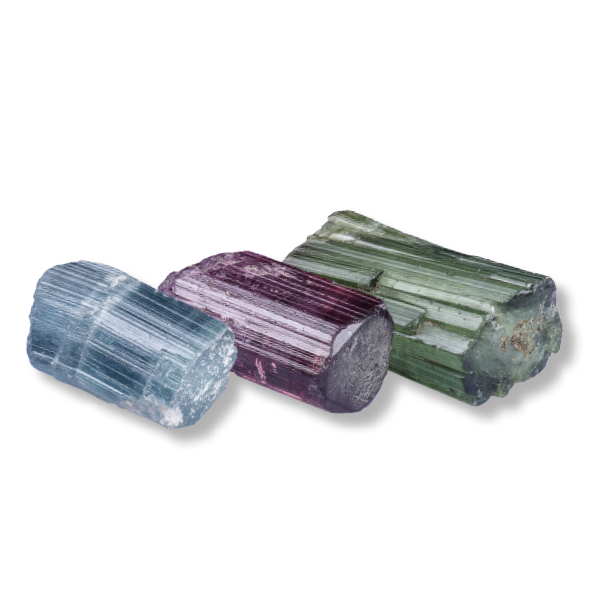 | 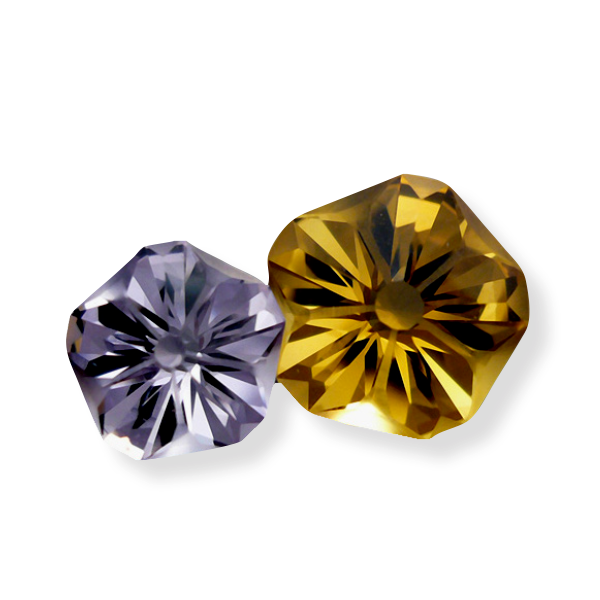 |
| Above: Tourmaline crystals | Above: Hanami-cut amethyst and citrine by Marco Voltolini |
Concluding thoughts
There are many types of cuts out there and many qualities of cutting. Like everything else when it comes to gemstones, the quality of the cutting has as much to do with the final appearance as the cutting style. A good design executed poorly will not enhance the appearance of a gemstone.
When a gem-cutter understands the basic laws of gemmology and has the right skills and equipment to give the stone a cut with an appropriate design, well-proportioned angles, and good meetpoints, the stone’s beauty will be maximised and can be enjoyed for a lifetime.
read emag